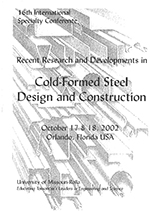Session Dates
17 Aug 2002 - 18 Aug 2002
Abstract
With the recent introduction of light gauge steel framing systems in the concrete-dominated Korean construction industry, more buildings are built with drywall that is mainly composed of steel studs and gypsum boards. While load-bearing steel studs are extensively applied in residential construction, nonload-bearing steel studs are applied in various building fields such as commercial, educational, as well as residential. As building projects involving steel stud walls are becoming to increase, higher demands in performance are requested from architects and builders, especially in the field of sound performance. A series of acoustic test were performed in the nationally certified sound-testing laboratory at Korean Institute of Construction Technology (KICT) in order to evaluate and analyze factors that influence acoustic performance of steel stud wall assemblies. Factors affecting the acoustic performance of steel stud walls that are analyzed in this paper include among others, the composition and structure of steel studs, stud spacing, stud thickness, stud size, use of resilient channel, screw spacing, etc. Factors relating to gypsum boards that were tested as part of the evaluation of acoustic performance are not included in this paper. Results of this study, which is co-funded by 3 major gypsum board companies in Korea, are being used to develop stud wall assemblies that meet the required acoustic performance for unit-to-unit separating walls, as well as present architects and builders with a better understanding on the sound behavior of steel stud drywall.
Department(s)
Civil, Architectural and Environmental Engineering
Research Center/Lab(s)
Wei-Wen Yu Center for Cold-Formed Steel Structures
Meeting Name
16th International Specialty Conference on Cold-Formed Steel Structures
Publisher
University of Missouri--Rolla
Document Version
Final Version
Rights
© 2002 University of Missouri--Rolla, All rights reserved.
Document Type
Article - Conference proceedings
File Type
text
Language
English
Recommended Citation
Chung, Hyun-Suk; Kim, Gap-Deug; Yang, Kwan-Seob; and Kim, Kyung-Woo, "A Study on the Factors That Influence the Acoustic Performance of a Steel Stud Wall Assembly" (2002). CCFSS Proceedings of International Specialty Conference on Cold-Formed Steel Structures (1971 - 2018). 6.
https://scholarsmine.mst.edu/isccss/16iccfss/16iccfss-session9/6
A Study on the Factors That Influence the Acoustic Performance of a Steel Stud Wall Assembly
With the recent introduction of light gauge steel framing systems in the concrete-dominated Korean construction industry, more buildings are built with drywall that is mainly composed of steel studs and gypsum boards. While load-bearing steel studs are extensively applied in residential construction, nonload-bearing steel studs are applied in various building fields such as commercial, educational, as well as residential. As building projects involving steel stud walls are becoming to increase, higher demands in performance are requested from architects and builders, especially in the field of sound performance. A series of acoustic test were performed in the nationally certified sound-testing laboratory at Korean Institute of Construction Technology (KICT) in order to evaluate and analyze factors that influence acoustic performance of steel stud wall assemblies. Factors affecting the acoustic performance of steel stud walls that are analyzed in this paper include among others, the composition and structure of steel studs, stud spacing, stud thickness, stud size, use of resilient channel, screw spacing, etc. Factors relating to gypsum boards that were tested as part of the evaluation of acoustic performance are not included in this paper. Results of this study, which is co-funded by 3 major gypsum board companies in Korea, are being used to develop stud wall assemblies that meet the required acoustic performance for unit-to-unit separating walls, as well as present architects and builders with a better understanding on the sound behavior of steel stud drywall.



